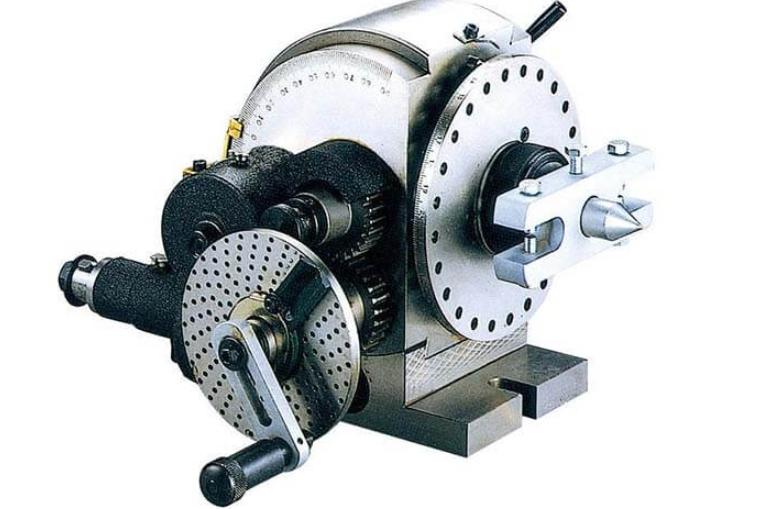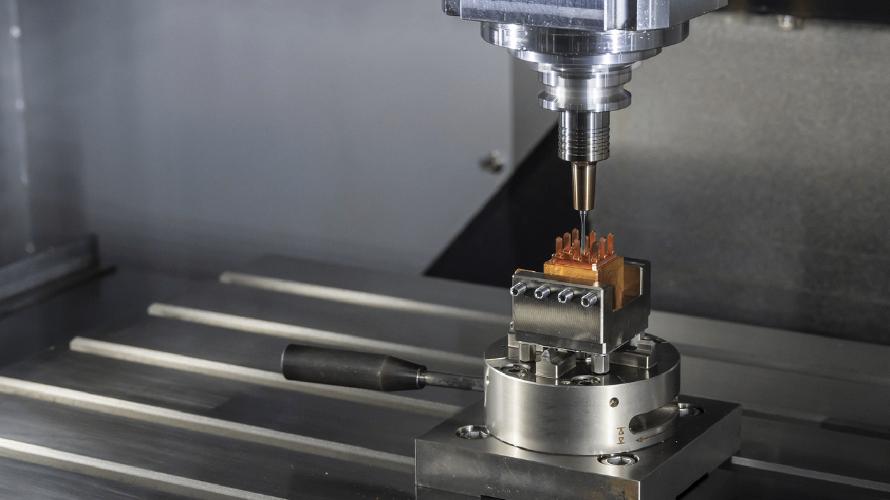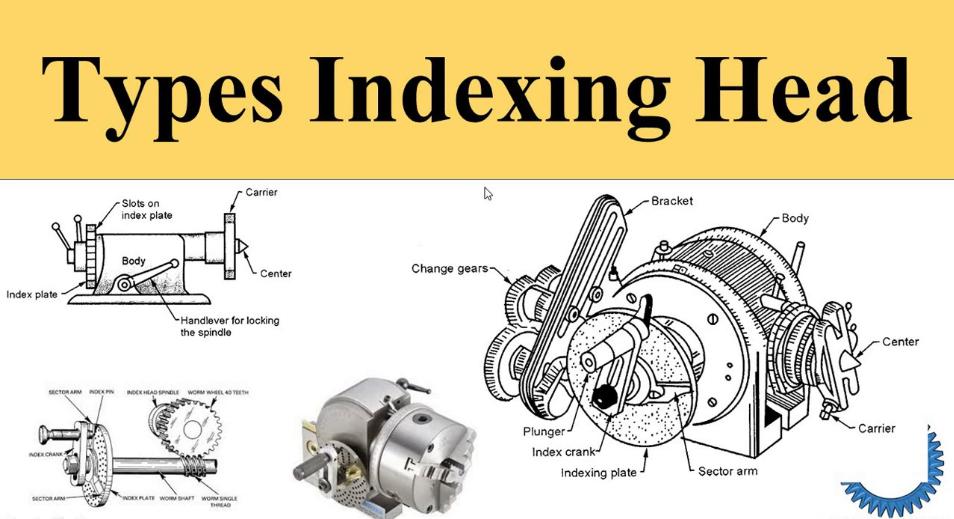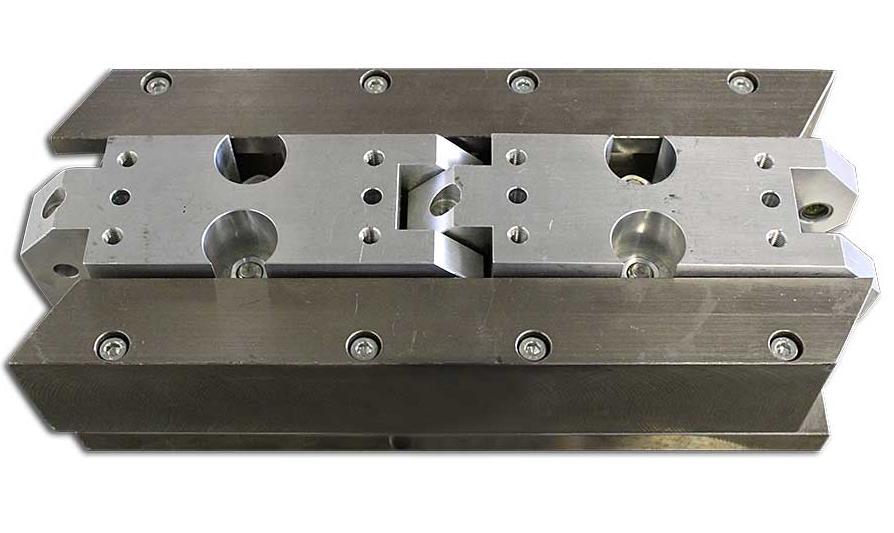The CNC Indexing Head is a landmark in modern machining, for it represents excellence and flexibility. Its gears and motors as well as software are integrated to convert materials into complicated parts.
Key in sectors such as the automotive to aerospace, this tool reshapes manufacturing efficiency. Its contribution to the development of technology is indisputable, changing our future for engineers.

CNC Indexing Heads, pivotal in machining, revolve workpieces with exceptional accuracy. Complex parts demand precise rotation, achieved through Hirth couplings, worm gears, and stepper motors.
Featuring 360° rotation, these heads offer 0.001° resolution. Employed widely in aerospace and automotive sectors, CNC heads bolster precision in multi-axis milling.
High-rigidity designs ensure minimal deflection during operation. Advanced models integrate seamlessly with CAD/CAM systems, enabling sophisticated control.
Maintenance demands remain low, thanks to robust construction. Often paired with ATCs (Automatic Tool Changers), they elevate efficiency. Their versatility extends to both horizontal and vertical machining centers.
CNC Indexing Heads ensure pinpoint accuracy in rotational movements. Vital for intricate parts, these heads achieve rotations with a resolution down to 0.001°. In operations like turbine blade manufacturing, precision rotation is key for dimensional accuracy.
Symmetrical components require uniform cutting, a task where CNC heads excel. They maintain perfect symmetry in operations such as turning circular parts. This rd capability is crucial in automotive industries for creating balanced, symmetrical parts.
In gear production, CNC heads facilitate exact angular placements. These placements are essential for tooth profile precision. CNC heads' role in gear machining underscores their importance in creating high-performance gears.
Essential in toolmaking, CNC heads precisely position for fluting tasks. They enable uniform groove cutting, critical in producing effective cutting tools. Fluting operations, especially in drill and end mill manufacturing, rely heavily on the accuracy of CNC heads.
For complex machining, accurate workpiece positioning is mandatory. CNC heads deliver precise orientation, indispensable in aerospace component manufacturing. Their ability to position workpieces accurately ensures high-quality outputs in complex machining processes.
CNC heads offer controlled, repeatable indexing for sequential operations. In mass production, this ensures consistency across multiple parts. Controlled indexing is particularly beneficial in automotive assembly lines, where uniformity is a key requirement.
Incremental adjustments are vital for precision engineering. CNC heads provide minute, controlled movements, essential in micro-machining.
These incremental movements are critical in industries where even a micron's difference matters, such as in semiconductor manufacturing.

CNC heads have exact tool taper interfaces that allow for firm, accurate holding. These interfaces, mostly BT or HSK types ensure stability in high-speed operations. Design of tool taper plays a crucial role in minimizing the time required for changing tools and increasing accuracy when it comes to CNC heads.
Axis indexing in CNC heads therefore provides highly accurate rotational movement control. They can index at micro-increments and this allows for complex geometries in multi-axis machining. One of the foundations for manufacturing complicated aerospace parts and highly detailed medical devices is Axis indexing accuracy.
Maximum speed in the CNC heads is a parameter that determines efficiency. The high-speedability, in many cases exceeds several thousand RPMs, aid cycle concentrations. In time-sensitive industries such as automotive manufacturing, the rapid machining processes made possible by these fast rotations are now more crucial than ever before.
The cutting force in CNC heads is powerful and consistent due to high torque. Such torque is critical for heavy duty machining that allows using strong materials with the ease of a breeze. High torque is especially beneficial in areas such as the heavy machinery industry that require strong material removal.
The power capacity of CNC heads determines their availability to perform tough tasks. The higher power ratings enable more intense and long-term operations. Such a capacity is especially important in industries that demand continuous machining operations involving high power, like energy and heavy industry.
The clamping force of CNC heads is instrumental in ensuring that workpieces are held firmly. A good clamping prevents movements during the machining thus ensuring precision and minimizing wastage. This force is very important in accuracy development, where even small movements cause huge deviations.
Temperature control in CNC heads ensures operational consistency. To avoid thermal distortion, they control heat buildup and maintain accuracy in machining. However, from the perspective of high-precision industries thermal expansion control is critical as small temperature variation can change product quality.

Direct Indexing heads, integral in machining, offer swift, precise angle positioning. Utilizing a plunger and hole system, they enable direct angle lock-ins. Essential for operations needing quick selection, accurate setups, they're widely used in toolrooms. Direct Indexing heads excel in tasks requiring frequent angle changes, like mold making.
Plain Dividing heads, the foundation of manual indexing, operate on gear and pinion systems. They're key in creating gears and helical cuts. Users turn a crank manually, aligning to specific divisions for angular accuracy. This type is favored in traditional workshops for its simplicity and reliability.
Universal heads, versatile in CNC machining, allow for both direct and differential indexing. Equipped to handle complex angle calculations, they're vital in intricate part manufacturing. Their adaptability makes them suitable for diverse machining tasks, particularly in custom part production.
Hydraulic Brake heads, known for robust clamping, use hydraulic power for secure locking. Ideal for heavy-duty machining, they ensure stability under high torque. Their use is prevalent in sectors requiring high-precision under intense machining conditions, like energy and heavy engineering.
Pneumatic Brake heads utilize air pressure for swift, efficient locking. Preferred in high-speed operations, they offer quick engagement and release. These heads are common in automated production lines, where speed and repetitive accuracy are paramount.
Roller Gear Cam heads, distinguished by their cam-driven mechanism, provide unparalleled precision. They're key in high-accuracy machining, especially in the aerospace and semiconductor industry. Their unique design minimizes backlash, enhancing overall machining precision.
Manual Tilt heads, offering angle adjustments by hand, are essential for bespoke machining tasks. They provide flexibility in adjusting the workpiece angle, crucial in prototype development. Often used in R&D and custom manufacturing, these heads are valued for their hands-on control.
Multi-Spindle heads, designed for simultaneous multiple operations, boost productivity. Capable of holding several tools, they're a boon in mass production. Their use significantly reduces cycle time, a critical factor in high-volume manufacturing sectors like automotive and consumer goods.
|
Type |
Description |
Rotation Ratio |
Indexing Plate Holes |
Tilt Capability |
Operation Mode |
Special Features |
|
Direct Indexing |
Rapid indexing to common angles using fixed holes on the plate |
40:1 |
Common angles like 30, 45, 90 degrees |
10° below to 90° vertical |
Manual |
Fast and simple; limited angles |
|
Plain Dividing |
Precise divisions using worm gear drive |
40:1 |
Varies; up to 400 holes available |
10° below to 90° vertical |
Manual |
Precise control of rotation; ideal for arbitrary angles |
|
Universal Head |
Allows machining of spiral/helical features |
40:1 |
Multiple sets (e.g., 24, 30, 36 holes) |
0° to 90° |
Manual with power drive option |
Versatile for complex shapes; can tilt spindle |
|
Hydraulic Brake |
Utilizes hydraulic mechanism for control |
N/A |
N/A |
N/A |
Hydraulic |
Precise stopping and holding; suitable for heavy loads |
|
Pneumatic Brake |
Employs pneumatic system for braking and holding |
N/A |
N/A |
N/A |
Pneumatic |
Quick response; suitable for lighter loads |
|
Roller Gear Cam |
Features roller gear mechanism for smooth motion |
N/A |
N/A |
N/A |
Manual or powered |
High precision and smooth operation |
|
Manual Tilt |
Manual adjustment of tilt angle |
40:1 |
Varies depending on model |
Up to 90° |
Manual |
Flexibility in adjusting tilt for specific operations |
|
Multi-Spindle |
Accommodates multiple spindles for simultaneous operations |
Varies |
Depends on the specific setup |
Varies |
Manual or CNC |
Enhanced productivity with multiple simultaneous operations |
|
Cincinnati Type |
Single plate with evenly distributed holes on both sides |
Calculated |
First side: 24-43 holes, Second side: 46-66 holes |
N/A |
Manual |
Versatile for complex indexing tasks |
|
Compound Indexing |
Combines two simple indexing movements for complex divisions |
Calculated |
Based on division requirement |
N/A |
Manual |
Allows for intricate and complex divisions |
In milling, CNC Indexing Heads play a pivotal role. They enable precise angle adjustments for complex milling operations. Utilized extensively in automotive and aerospace engineering sectors, these heads are crucial for manufacturing intricate engine components and aircraft parts.
The holes can be placed with high accuracy by the CNC heads that spearhead drilling procedures. Theirs uses are widespread among the sectors rife with high precision drilling machines such as oil and gas exploration companies, manufacturing of medical equipment.
The productivity of CNC heads is especially evident when precise holes are produced in hard-to reach locations within a deep or pocket
Due to the accuracy in positioning tools that CNC heads provide, grooving requires them. They play a crucial role in operations that produce identical grooves, including musical instruments and precision engineering parts production. This quality of precision however is vital for obtaining the correct depth and symmetry in grooves.
Such are the CNC heads, which prove invaluable during inspection processes. They ensure precision positioning by the measurement gauges taken to ascertain dimensional accuracy for components.
This application is crucial to use in quality control departments throughout industries, more so the aerospace and automotive manufacturing where accuracy cannot be compromised.
In automation, CNC heads significantly increase the traceability. They are the critical elements for automated machining cells, minimizing manpower and maximizing speed of process. Thus for high volume production of precision oriented the electronics and some consumer goods are dependent on these heads.

The CNC Indexing Heads have unparalleled accuracy in production. They play an important role in manufacturing components with high precision that are key in industries like aeronautics and medical devices.
These heads considerably accelerate the manufacturing processes. They decrease cycle times—an important factor in mass production environments due to how fast and precise movements they make possible.
These CNC heads are reliable. The strength of their design allows for high-quality and replicable performance, especially in sectors where downtime is expensive, likes the automotive sector.
Because of its versatility CNC heads are suitable for various applications. They are versatile enough to carry out the simplest of drilling work as well as complicate.
With CNC heads, human error is minimized by automating the finer movements. This results in improved quality of products, lower wastage with particular emphasis to high precision industries.
CNC heads are fully compatible with automation systems. They improve the performance of automated manufacturing systems, thereby boosting efficiency and output in areas such as consumer electronics industries and industrial machinery.

Correct positioning of CNC Indexing Heads ensures accuracy. Accuracy of machining shall be prevented by ensuring the alignment with spindle axis. This alignment is maintained by regular checks with precision tools such as dial indicators which are crucial to obtaining quality outputs.
A constant lubrication ensures the long life of CNC head. Wear and overheating are potentially avoided through non-lubrication, which leads to friction reduction. Essential is using the oils and greases recommended by manufacturers. Planned lubrication keeps the life of moving parts, guaranteeing its smooth operation.
Regular calibration of CNC heads ensures precision. Calibration guarantees that the head’s indexing is accurate. Standard calibration procedures should become a regular practice, especially after long usage or repair.
Wear monitoring on CNC heads prevents unscheduled failures. Wear signs are detected during regular inspections. Guidance to details such as bearings and gears is necessary. Replacement of worn parts in a timely manner ensures performance and avoids expensive shutdown due to downtime.
It is paramount to update CNC head software. Many software updates come with performance enhancements and error corrections. Frequent updates guarantee compatibility with the modern machining software and enable additional functionality.
CNC heads should be cleaned regularly for high performance. Cleaning of pollutants and cutting fluids residues prevents corrosion and accumulation. A cleaned head works better, reducing the likelihood of faults.
CNC heads should run at their optimum level by conducting regular professional inspections. Experts help in detecting those problems that are not visible easy. In conjunction with maintenance records, these inspections maintain the heads in optimum condition that is essential for complex manufacturing operations.
CNC Indexing Heads ensure remarkable accuracy, reaching tolerances up to 0.01 mm. Complex shapes, once a challenge, are now easily achievable. High-precision gears in the indexing head maintain this accuracy consistently. Axis movement synchronizes perfectly, enhancing exactness. Reliability in repetitive tasks outshines traditional methods.
Speed in production skyrockets with CNC Indexing Heads. Tasks that took hours now complete in minutes. Rapid tool changes facilitated by automated systems cut down idle times. Enhanced spindle speeds reach 7500 RPM, accelerating machining processes. Production timelines shrink, boosting overall output significantly.
Versatility in CNC Indexing Heads shines in multi-axis capabilities. Adaptability to various materials, from metals to polymers, is a key advantage. Tailoring operations for intricate designs becomes effortless. Attachments like rotary tables expand functionality further. Versatility in these heads translates into broader manufacturing possibilities.
Precision in CNC Indexing Heads is unparalleled. Fine-tuning for intricate details is highly efficient. Advanced calibration techniques ensure utmost precision.
The integration of software and hardware leads to exacting outcomes. Precision is maintained throughout long production runs, a feat traditional methods struggle with.
CNC Indexing Heads significantly minimize material waste. Precise cutting reduces excess material usage. Optimized tool paths programmed in the system further reduce waste.
Efficient use of raw materials is not only cost-effective but also environmentally friendly. Traditional methods pale in comparison in waste management.
Lower costs emerge as a key benefit of CNC Indexing Heads. Reduced material waste leads to savings. Minimized manual labor cuts down operational expenses.
Long-term durability of CNC equipment means less frequent replacements. Overall, the cost-effectiveness of CNC technology outweighs traditional methods.
Simplification of operations is evident with CNC Indexing Heads. User-friendly interfaces make programming less complex. Automated systems reduce the need for manual intervention.
Consistency in production eliminates frequent adjustments. Simplified operations lead to increased efficiency and lower training requirements. Traditional methods can't match this level of simplicity.
Q. What is a CNC Indexing Head?
A. CNC Indexing Heads, pivotal in precision engineering, transform raw materials into intricate parts. Equipped with advanced gears and motors, these heads facilitate accurate rotations.
Compatibility with diverse CNC machines enhances their utility. Essential in complex manufacturing, they're synonymous with modern machining efficiency.
Q. How does a CNC Indexing Head work?
A. CNC Indexing Heads operate by synchronizing spindle movements with programmed instructions. Intricate rotations are executed with precision. Controlled by advanced software, these heads ensure accurate positioning. Their functionality is key in producing complex geometries. Seamless integration with CNC systems makes them indispensable for precision tasks.
Q. What are the types of CNC Indexing Heads?
A. Diversity in CNC Indexing Heads includes manual, semi-automatic, and fully automatic types. Manual heads require operator intervention for adjustments. Semi-automatic versions blend manual settings with some automation. Fully automatic heads, the most advanced, operate entirely under programmed control. Each type caters to different machining complexities.
Q. What applications are CNC Indexing Heads used for?
A. CNC Indexing Heads find widespread use in various sectors. Automotive industries rely on them for precise engine parts. Aerospace applications benefit from their ability to craft complex components.
In the world of robotics, they're crucial for creating intricate assemblies. Their versatility extends to medical device manufacturing and more.
Finally, the CNC Indexing Head is a critical tool in modern manufacturing that provides superior accuracy and flexibility. This guide has shown how fundamental this is in different fields. If you want to learn more about CNC Indexing Heads and its disruptive innovation visit CNCYANGSEN. CNC Indexing Head is the future of machining, embrace it.